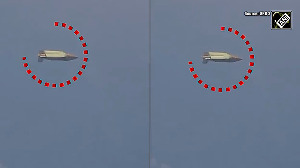 Movies, that were shot on celluloid film and reached cinema theatres on spools packed in grey coloured tin cans, may soon be part of the coveted film memorabilia found at auctions. The old celluloid prints are dead. Long live the films!
Movies, that were shot on celluloid film and reached cinema theatres on spools packed in grey coloured tin cans, may soon be part of the coveted film memorabilia found at auctions. The old celluloid prints are dead. Long live the films!
We may not be far from writing the epitaph of the conventional film format as new technology arrives centrestage to change the face of cinema around the world.
Films that you may be watching on giant screens in a theatre near you, will now come as data that can be copied on to a diskette, or transmitted through satellite or broadband, straight to the cinema halls.
Digital cinema is the new technological revolution sweeping the film and entertainment industry across the world. Though consumers have savoured digital experience on their home entertainment systems, it is now time for motion pictures to move from celluloid films to the digital format.
Hollywood has already taken the lead. This year, several US studios are planning to shoot a majority of their films in the digital format (See below, Hollywood's digital highway). Exhibitors are investing in installing servers to receive and store films and putting up digital projectors to ensure that these movies can be played on the screens.
In the process, the good old film distribution system is being turned on its head with film producers weighing the pros and cons of new delivery mechanisms -- satellite, the fibre optic backbone and diskettes --to replace the conventional film prints that were delivered physically to the exhibitors.
The digital drama is unfolding in India too. Producers and exhibitiors view digital technology as a viable way to penetrate new markets. Today, nearly 70 per cent of cinema revenues come from the metros and the first day, first show phenomenon bypasses the smaller cities and towns.
Observes PVR Cinemas' Delhi-based managing director, Ajjay Bijli: "In India digital technology is a means to penetrate class B and C cities where cinema halls get a new movie much later than their counterparts in the metros." The reason: prints are expensive and these markets are too small to justify the cost.
Small wonder then Bijli is already working on a plan to set up digital cinema theatres across such towns and reckons that each large exhibitor could easily put up a 200-theatre chain of digital cinema halls to ensure that the films see a simultaneous, all-India release.
The company is also exploring the satellite and fibre optic options for film distribution. It expects its first digital theatre to be operational in the next four months.
Bijli is not the only player in the entertainment business riding the digital wave. Film production houses are also in the fray. Mumbai based UTV Software Communications Ltd (which produces as well as distributes films), for instance, thinks that delivering films to theatres via satellite makes good business sense.
The company is keen to get into the exhibitions business through management contracts with cinema owners. Says Ronnie Screwvala ,CEO of UTV: "We need a technological USP. And one option is to offer satellite distribution."
The potential of digital entertainment is enticing the telecom companies too. Reliance Infocomm, for instance, wants to get into the digital carriage way business by offering its underground fibre optic cable network to theaters across the country.
Entertainment industry analysts say that by acquiring Adlabs (runs multiplexes and a film processing unit), the company wants to stride the complete entertainment value chain -- from film content to distribution through its cable network, to exhibition at theatres controlled by Adlabs across the country.
Meanwhile, Tata-controlled Videsh Sanchar Nigam Ltd has also tied the knot with French electronics giant Thomson to offer end-to-end solutions for digital cinema. Says N Srinath, director (operations) at VSNL: "We hope to offer content management solutions and satellite distribution to third party users."
Bharti, currently testing its broadband backbone to homes, will also use the same pipe to deliver movies to cinema houses. Says Jagbir Singh, CTO, Bharti Televentures: "All you need is a fibre to the hall that offers a speed of 25 mbps to 30 mbps. The multiplex would need to spend another Rs 300,000 500,000 on digital equipment."
Cheaper options
Other than exhibitors and distributors, even content creators are going digital. The trend was set by Adlabs (now owned by ADAE) which is expected to release 30 digital films by 2006 including Mangal Pandey - The Rising this week.
Taking a cue, production house Sahara India Entertainment Management Co. Ltd also plans to make three to five films in the digital format next year. "Digital films are much faster and substantially cheaper to produce," says Sahara Entertainment's managing director Shailendra Singh.
It's not difficult to see why the entertainment industry stakeholders are switching to digital technology. Economics is the key, they claim. Cost of a 35 mm film print, at Rs 60,000 to Rs 70,000 for a roll, is steep.
Screwvala says that for a mid-budget film (about Rs 10 crore or Rs 100 million), it accounts for over 20 per cent of the cost. And that may be pushing people to experiment with alternative and cheaper distribution channels. Sunil Patel, PVR's head of technology, says that a digital disk (like a DVD) couriered to a cinema hall would cost only Rs 200.
"Lower distribution cost could help us cut the price of the film ticket from the current Rs 100-150 to Rs 30-40 per ticket in the metros," he says.
On an average, Indian producers make about 200 to 300 prints of a new film and manage to cover not more than 700 cities during the first phase of the launch. The remaining markets are totally lost to the producers and are often fed by pirated copies that eat into the revenues of the film.
The new digital delivery mechanism also offers flexibility to exhibitors. If a movie is a hit at a multiplex, the owner can start an additional show on another screen. If the situation is reverse, he can take the film off his theatre without worrying too much about the cost of the print.
The new technology will also bring in additional revenue as film theatres can beam live shows or sports event by using the digital system hooked on to the satellite or the fibre optic network.
Opinion, however, is divided on the cheapest and the best way to distribute films to cinema halls. Screwvala, the UTV boss, says that distributing films through satellite is cheap as transponder costs have crashed. "You can lease one for about Rs 2 crore (Rs 20 million) and there is enough bandwidth to distribute films to more than 200 cinema halls."
Adds Jawahar Goel, vice chairman of the Zee group: "Satellite is the best form of delivery for e-cinema as there's no last mile fibre optic connectivity even in A class cities let alone the smaller cities." Goel refuses to divulge the group's plans in the area though it owns multiplexes and head-ends in the sky.
Sahara's Singh votes for the satellite route though the company may evaluate the fibre optic option as well. But PVR's Patel isn't too happy with the price quoted by satellite operators. Rs 7,000 for a film per download is steep compared to the Rs 200 for a diskette, he feels.
But he points out that fibre optic could be cheaper if the last mile connectivity is ensured. At least one telecom company has offered to download a film though the fibre cable for half the price of satellite. "At that price it looks viable as it is a much more secured way of transmitting movies to halls than a diskette," he concedes.
Telecom firms believe that using diskettes as an alternative to film prints does not resolve the fundamental issue of piracy or under-invoicing of shows by theatre owners. The answer lies in satellite or fibre.
Says VSNL's Srinath: "Producers worry whether their rights will be protected and if the film is being screened according to the agreed number of times. Film prints do not resolve these issues. That is where we get in."
Apart from satellite distribution, VSNL is also offering a digital rights management system for producers to ensure that their patent rights are protected (the system allows transparency in calculating the number of times the film was shown to avoid under-invoicing). And with various encryption and decryption technologies available it will be difficult to make pirated copies.
Of course, some challenges remain. In the US, producers and exhibitors are warring over costs. Exhibitors claim that they will have to make huge investments in their theatres without any visible benefits or returns.
The digital projectors for high quality digital films will cost as much as Rs 60 lakh to Rs 80 lakh (Rs 6-8 million) -- nearly six times more than a regular celluloid projector cost. The argument is that the producers must bear part of the refurbishing cost.
The Indian challenge is more complex. Says an industry observer: "Our film distribution system is complicated -- there are distributors and sub distributors who cannot be wished away." Also, unlike in the US, the market is fragmented: there are over 12,000 cinema houses and only 150 of these are multiplexes.
"So as a supplier I have to talk to 10,000 different owners to offer these services," says a telco executive. Distribution through satellite or fibre optic makes business sense if you have a minimum number of auditoriums under your control, he adds.
Yet, Indian theatre owners know that sooner or later they will be pushed into investing in digital projectors as most Hollywood movies are slated for production in high quality digital formats.
Says Kajal Aijaz , CEO, Digital Talkies (DLF group) which is setting up multiplexes in Punjab: "We will have at least one digital screen in the multiplexes that we're planning."
Clearly, the technological leap into digital cinema space and the resultant benefits may push us to pen the epitaph of the celluloid sooner than we imagine.
Hollywood's Digital Highway
You are about to experience the pleasures of digital cinema in a theatre near you, soon. Major Hollywood studios have already given an undertaking that as much as 75 per cent of all the films next year will be shot in the digital format. Film industry experts say that in five years nearly 50,000 theatres in the US will become digital.
The Digital Cinema Initiative, that's coming to fruition now, was launched in March 2002 as a joint venture of Disney, Fox, MGM, Paramount, Sony Pictures Entertainment, Universal and the Warner Brothers studios. The primary objective of the initiative was to establish voluntary specifications and standard for digital cinema.
Last month, the global majors managed to unanimously fix the standards that lay down the overall system requirements and specifications to help theatrical projector and equipment manufacturers create uniform and compatible digital cinema equipment throughout the United States.
Experts in India say that the standards chosen by the US are essentially meant to produce high quality films, offering a 3D experience which will require substantial investments to be made by theatre owners. In fact digital equipment manufacturers are already offering schemes that make it more cost effective for exhibitors to upgrade their auditoriums.
Anil Dhirubhai Ambani Enterprises: Anil Ambani
It wants to offer digital carriageway to films through its fibre optic backbone. Media industry experts believe that through its acquisition of Adlabs, the company will get into production, distribution and exhibition of films.
UTV: Ronnie Screwvala
It is eyeing the film exhibition business and exploring management tie-ups with cinema owners. It is open to distribution of films through the satellite route as transponder costs have crashed.
Sahara India: Subroto Roy
Plans are underway to make 3-5 digital films next year. The group is looking at both the satellite and the fibre optic options to distribute films in its proposed multiplexes
VSNL: N Srinath
VSNL has tied up with French electronics giant Thomson to offer end-to-end solutions for digital cinema toa third party. This includes distribution of films through satellite and digital rights management of films so that their IPR is protected.








 © 2025
© 2025